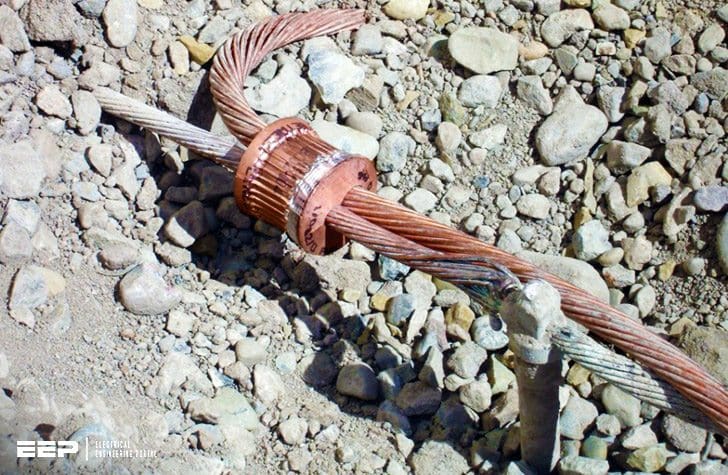A quick search for earth tape didn't come up with much, though this thread was of interest.
I'll start by mentioning that I've led a sheltered life and only ever dealt with PME (TN-C-S) so never had to deal with earth rods.
At our church, we've had an inspection of the lightning protection system (LPS), and as I expected the report's come back saying it doesn't comply with LPS standards but "There are hundreds of churches with lightning protection fitted to just the bell towers & spires only, they do not comply with LP standards, but the limited zones of protection provided by them is accepted as the norm, as long as the earth resistance on the system is 10.0 ohms or below."
I suspect most of you are ahead of me here, needless to say our earth rod doesn't give 10 ohms. It's reading 230 ohms ?
Talking to one of the church wardens, he recalls when the current one was fitted. It was to replace another that he described as "about 4 foot long, and when the guy had hammered it in, there was still two foot sticking up out of the ground", adding that the guy said "that's about as good as you'll get" as he'd just hit rock.
I can't see much point trying to get any decent rods in the ground, so tape seems a better bet. I'm thinking if we hire a mini digger over a weekend, we should be able to get a decent length buried - and put some service ducts in while we're at it for other things we've been thinking about.
The good news is that this is on the north side of the church, never gets any sunlight, and as far as I know, never dries out ?
As an aside, I asked them for their guidance regarding bonding of the electrical earth to the LPS earth, their suggestion was that given the high impedance of the current earth, it would be rather pointless. Assuming we get a decent earth, it's my intention to bond as per BS7671.
So for those with experience of such things ...
Anyone got any thought what sort of length we'd need to bury ?
Pointers to guidance on how to calculate (or at least, guesstimate) in advance how much we might need ?
And assuming I get a decent earth, what's the correct way to connect a bonding cable to the LPS conductor (in the earth rod pit, to the tape down the building (below the test/isolation joint)) ?
If necessary I can probably borrow an earth rod test rig - I'm thinking I'll need one to test it afterwards and see what we've got, and also it might be an idea to measure the soil resistivity before we start.
Obviously if funds were plentiful we could just get someone in with a remit of "make it so". But funds, in common with most rural churches, are very much not plentiful ?
Thanks for any insight anyone can give.
I'll start by mentioning that I've led a sheltered life and only ever dealt with PME (TN-C-S) so never had to deal with earth rods.
At our church, we've had an inspection of the lightning protection system (LPS), and as I expected the report's come back saying it doesn't comply with LPS standards but "There are hundreds of churches with lightning protection fitted to just the bell towers & spires only, they do not comply with LP standards, but the limited zones of protection provided by them is accepted as the norm, as long as the earth resistance on the system is 10.0 ohms or below."
I suspect most of you are ahead of me here, needless to say our earth rod doesn't give 10 ohms. It's reading 230 ohms ?
Talking to one of the church wardens, he recalls when the current one was fitted. It was to replace another that he described as "about 4 foot long, and when the guy had hammered it in, there was still two foot sticking up out of the ground", adding that the guy said "that's about as good as you'll get" as he'd just hit rock.
I can't see much point trying to get any decent rods in the ground, so tape seems a better bet. I'm thinking if we hire a mini digger over a weekend, we should be able to get a decent length buried - and put some service ducts in while we're at it for other things we've been thinking about.
The good news is that this is on the north side of the church, never gets any sunlight, and as far as I know, never dries out ?
As an aside, I asked them for their guidance regarding bonding of the electrical earth to the LPS earth, their suggestion was that given the high impedance of the current earth, it would be rather pointless. Assuming we get a decent earth, it's my intention to bond as per BS7671.
So for those with experience of such things ...
Anyone got any thought what sort of length we'd need to bury ?
Pointers to guidance on how to calculate (or at least, guesstimate) in advance how much we might need ?
And assuming I get a decent earth, what's the correct way to connect a bonding cable to the LPS conductor (in the earth rod pit, to the tape down the building (below the test/isolation joint)) ?
If necessary I can probably borrow an earth rod test rig - I'm thinking I'll need one to test it afterwards and see what we've got, and also it might be an idea to measure the soil resistivity before we start.
Obviously if funds were plentiful we could just get someone in with a remit of "make it so". But funds, in common with most rural churches, are very much not plentiful ?
Thanks for any insight anyone can give.










